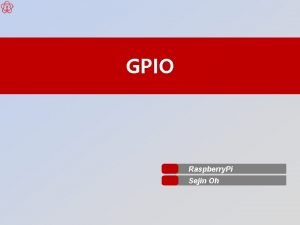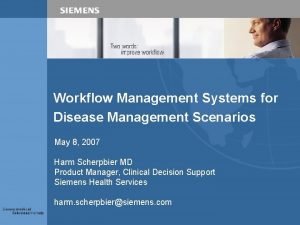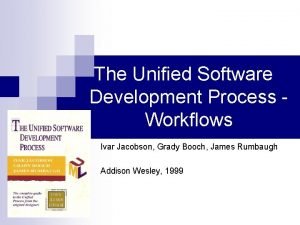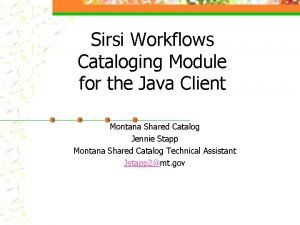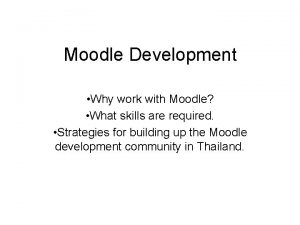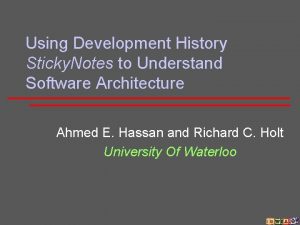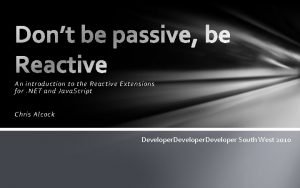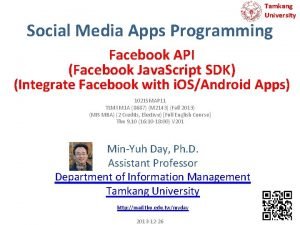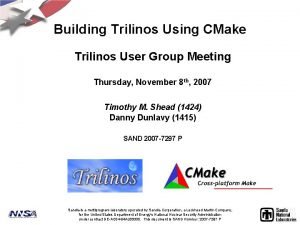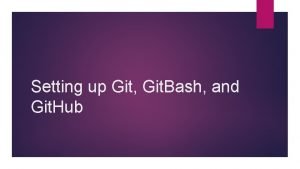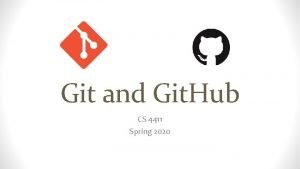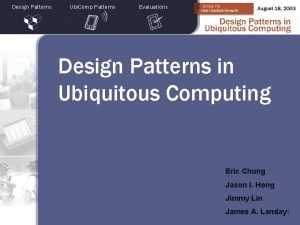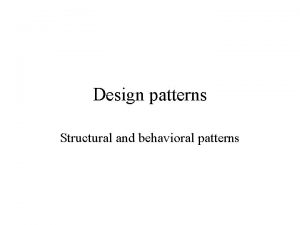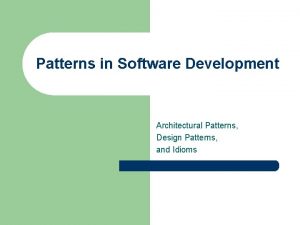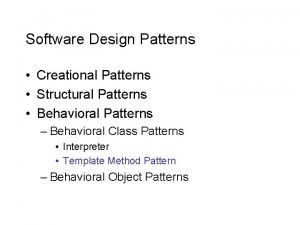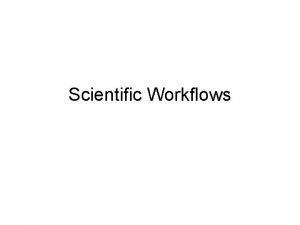Design Patterns for Git Workflows Trilinos Spring Developers





















- Slides: 21

Design Patterns for Git Workflows Trilinos Spring Developers Meeting May 13, 2015 Roscoe A. Bartlett Oak Ridge National Lab • Computational Eng. & Energy Sciences • Computer Science and Mathematics Div

Background on Git Workflows • 2005: Git development begins (Linus Torvalds, for Linux Kernel) • 2010: “Gitflow” is presented (Vincent Driessen) – Uses ‘develop’ and ‘master’ branches with short-lived “feature”, “release” and “hotfix” branches – Most well known and popular git workflow (by far) – Every workflow since compares itself to gitlfow (and criticizes gitflow in the process) • After Gitflow: 2 – “Github Flow”: Advocated by Github • Simple feature branches with pull requests – “Simple Git Workflow is Simple”: Advocated by Atlassian • Simple feature branches with rebasing on top of ‘master’ and --no-ff merges to ‘master’ – “Gitlab Flow”: Advocated by Gitlab team – “Git. git Worklow” (i. e. “gitworkflows(7))”: Official git man page “gitworkflows(7)” • All feature branches with ‘next’ and ‘pu’ temp testing branches, graduate to ‘master’. Use by the developers for git itself (i. e. git) Managed by • UT-Battelle for the U. S. Department of Energy Git Workflows for CSE • Used by Linux Kernel developers

Overview of Existing Defined Workflows 3 Managed by UT-Battelle for the U. S. Department of Energy Git Workflows for CSE

Github Flow • Permanent branches: ‘master’ • Primary focus of testing: Each individual feature branch • Notes: – No release branches! (can’t support multiple releases) 4 Managed by UT-Battelle for the U. S. Department of Energy Git Workflows for CSE

Gitflow • Permanent branches: ‘develop’ and ‘master’ • Short-lived branches: “feature”, “release”, and “hotfix” • Primary focus of testing: ‘develop’ branch (but still need testing on ‘master’ if ‘hotfixes’ exist) 5 by UT-Battelle • Managed gitofcommand systems has Gitbeen created to drive workflow! (Criticized as for. Special the U. S. Department Energy Workflows for CSE too complex)

MOOSE Workflow (Gitflow + Github Flow) 6 Managed by UT-Battelle for the U. S. Department of Energy Git Workflows for CSE

Git. git Workflow “gitworkflows(7)” (PETSc) 7 Managed by UT-Battelle for the U. S. Department of Energy See: Gitworfkows( 7) man page Gitworkflows (7) presentation Git Workflows for CSE

Design Patterns for Git Workflows 8 Managed by UT-Battelle for the U. S. Department of Energy Git Workflows for CSE

Incrementally Expanding Git Workflow (Intro) • Instead of defining complete workflows to choose from => Define git workflow “building blocks” and construct the workflow that is need! • Workflow Construction Steps: – Consider the properties and challenges for a given project – Construct simplest git workflow using building blocks to meet current needs – Add new features to workflow as situation changes and more challenges emerge • Workflow building blocks – – – – Begin: The simple centralized CI workflow Addition of a ‘develop’ branch These can be added to a git workflow in Addition of topic branches almost any order! Addition of a subteam branch Addition of release branches Addition of feature branches Addition of throw-away integration test branch(es) End: The Git. git Workflow (e. g “gitworkflows(7)”) • Consistent with “gitworkflows(7)” https: //www. kernel. org/pub/software/scm/git/docs/gitworkflows. html 9 Managed by UT-Battelle for the U. S. Department of Energy Git Workflows for CSE

Issues to Consider to Select Git Workflow • Number of developers • Distribution of general software knowledge and skills of the developers • Distribution of git-specific knowledge and skills of the developers • Amount of (or lack of) communication and coordination between the developers • Nature of the customers and need for releases of the software • Sensitivity of the software (e. g. security vulnerabilities? ) • Rate of development and change in the software • Importance (and urgency) of performing code reviews • Portability requirements and portability challenges of the software • Heterogeneity of the development and testing environments 10 Managed by UT-Battelle for the U. S. Department of Energy Git Workflows for CSE

Testing Issues/Support for Git Workflows Test Suites: • CI Build: This is a Continuous Integration (CI) [2, 3] build of the code on a single platform and single configuration and the running of a (relatively) fast test suite. The CI Build should be constructed so that it protects the major features of the code that are needed by the other developers to continue their development work. The CI Build would be performed before any branch is updated that impacts other developers. This is the pre-push regression test suite described in [1]. • Nightly Builds: This is a collection of builds on different platforms with different compilers and running a more comprehensive (i. e. expensive) test suite. This is the nightly regression test suite described in [1]. Testing assumptions: • Additive test assumption of branches: If ‘m + a’ PASSES and ‘m + b’ PASSES, then ‘m + a + b’ also PASSES “How to Add and Testing in CSE Software IDEAS Project, • [1]Subtractive test. Improve assumption of. Your branches: If ‘m +Project”, a + b’ PASSES then 2015. ‘m + a’ or ‘m + b’ [2]also “Continuous Integration”, Wikipedia, http: //en. wikipedia. org/wiki/Continuous_integration PASSES. [3] Fowler, Martin. “Continuous Integration”, http: //martinfowler. com/articles/continuous. Integration. html 11 Managed by UT-Battelle for the U. S. Department of Energy Git Workflows for CSE

Begin: Simple Centralized CI Workflow A 1 B 1 A 2 A 3 B 2 C Dev 1 master D Dev 2 • Features implemented in commits intermingled on ‘master’ branch – Feature “A”: Commits “A 1”, “A 2”, “A 3” – Feature “B”: Commits “B 1”, “B 2” – Feature “C”: Commit “C” • Pros and Cons (w. r. t. other more sophisticated workflows): – Pro: Simplest workflow with fewest git commands, no distributed VC concepts (i. e. SVN -like) – Pro: Requires least knowledge of git – Pro: Minimizes merge conflicts (frequent pushes to and pulls from ‘master’) – Con: Difficult to perform pre-merge code reviews – Con: Difficult to collaborate with other developers with partial changes (can’t push broken code to ‘master’ to share with others) – Con: Difficult to back out bad feature sets – Con: Difficult to maintain 100% passing tests for all Nightly Builds • Example project: New research project 12 – Small number of closely collaborating developers – by. No real users (e. g. no need to support releases) Managed UT-Battelle for the U. S. Department of Energy Git Workflows for CSE

Addition of a ‘develop’ branch master (Rare) Bug fix on ‘master’ M 1 M 2 bug-fixpromotion A 1 Passes nightlies A 2 Fails nightlies Bug fixes to allow merge to ‘master’ Close Users M 3 M 4 M 5 ‘develop’ always contains ‘master’ B 1 Fails nightlies develop B 2 Passes nightlies C Passes nightlies D • Introduce a ‘develop’ branch: – Developers directly push to ‘develop’ branch using CI Build (i. e. simple centralized Devs CI workflow) – Only merge from ‘develop’ into ‘master’ when all Nightly Builds pass (perhaps with minor bug fixes) – Temp ‘bug-fix-promotion’ branch can be used to stabilize and fix bugs before update of ‘master’ – Close users pull from more stable ‘master’ branch (‘master’ is default branch when cloning a git repo!) – Most testing focused on ‘develop’ branch. (Little to no testing needed on ‘master’) • Pros and Cons (w. r. t. single branch workflow): 13 – Pro: Developers still only perform simple centralized CI workflow (only on ‘develop’ not ‘master’) – Pro: More stable ‘master’ branch seen by users – Pro: Allows some time for review of commits on ‘develop’ before merge to ‘master’ Managed UT-Battelle – by. Con: Requires knowing how to use. Gitmultiple branches and merges for the U. S. Department of Energy Workflows for CSE – Con: Extra effort to perform merges from ‘develop’ to ‘master’ (or could use cron job to

Addition of topic branches C A 1 B 1 1 st topic branch for feature A Branch for compete feature B Or ‘master’ branch if not using a ‘develop’ branch D direct commit A 2 develop A 3 2 nd topic branch for feature A B 2 • Introduce usage of temporary short-lived topic branches: – Developers (optionally) implement features in one or more topic branches and merge to ‘develop’. E. g. : • Feature “A”: 1 st topic branch (commits “A 1”, “A 2”), 2 nd topic branch (commit “A 3”) • Feature “B”: Single topic branch (commits “B 1”, “B 2”) – Topic branches pass CI Build merged into ‘develop’ about once/day or 4 -6 hours of work (rule of thumb) – Direct pushes to ‘develop’ are okay for single commit changes that are not shared/reviewed. – NOTE: Usage of topic branches does not degrade CI at all! Does not lead to more merge conflicts! – NOTE: Not typically long-lived “feature branches” that are hard to merge back! • Pros and Cons (w. r. t. single branch workflow): 14 – Pro: Allow changes to be easily backed out if something goes wrong – Pro: Allow switching between different topic branches quickly – Pro: Allow easy sharing for quick collaboration with other devs before merging to Managed ‘develop’ by UT-Battelle for the U. S. Department of Energy Git Workflows for CSE – Pro: Allow quick code reviews (pull-requests) on the topic branch before merging to

Addition of a subteam branch Subteam developers collaborate directly on ‘st-dev’ branch using just the simple centralized CI workflow. Subteam Dev 1 Merge updates from ‘develop’ to/from ‘st-dev’ when needed and/or desired. Subteam Dev 2 Subteam Integrator Code reviews can take place on ’st-dev’ branch and issues addressed with new commits before merge to ‘develop’. Only Subteam Integrator needs to deal with multiple branches, merge commits, etc. st-dev Use separate repo where this branch is the default branch after clone. Merge commits can be backed out if problems are found after merge. develop • Works well when: Dev 1 Dev 2 – Changes by subteam commits don’t typically conflict with commits on main ‘develop’ branch. – Criteria for pushing to ‘st-dev’ branch may be different than for pushing to ‘develop’ branch. • Pros and Cons (w. r. t. topic branch workflow): 15 – Pro: Most subteam developers only need to know and use the Simple Centralized CI Workflow – Con: Can create messier git history (e. g. can’t ‘git rebase -i’ to clean up ‘st-dev’ before Managed by UT-Battelle for the U. S. Department of Energy Git Workflows for CSE merge to ‘develop’)

Addition of release branches v 2. 2. 4 i. e. many commits later v 2. 2. 5 v 2. 3. 0 rc. 1 Bug fix that affects v 2. 2 and forward branches release 2. 3 -start v 2. 3. 0 dev release-2. 2 v 2. 3. 0 v 2. 3. 1 release-2. 3 Merge forward v 2. 3. 0 rc. 0 Update for release v 2. 4. 0 dev ‘master’ contains all release branches External Users master • Introduce long-lived release branches: – Follows “Semantic Versioning” standard recommended by Github (http: //semver. org): Devs • Release tag: v. X. Y. Z (X = major, Y = minor, Z = patch), Release candidate: v. X. Y. 0 -rc. Z – Apply bug fix to oldest release branch that needs the fix then merge forward (“gitworkflows(7)”) – Cherry-picks from upstream to downstream also allowed (but not preferred) – NOTE: Since ‘master’ contains all release branches, then just testing ‘master’ provides some release testing. • Pros and Cons (w. r. t. single ‘master’ branch which provides a single stream of releases): 16 – Pro: Allow support for multiple releases – Pro: Allows customers to depend on well-defined named versions of the software – Con: More labor and more testing needed to maintain old releases Managed by UT-Battelle for the U. S. Department of Energy Git Workflows CSE • Example project: Established project with formany customers requiring stable named

Addition of release branches (w ‘develop’) v 2. 2. 4 release-2. 2 v 2. 2. 5 Bug fix that affects v 2. 2 and forward branches release 2. 3 -start v 2. 3. 0 dev External Users v 2. 3. 0 v 2. 3. 1 release-2. 3 Merge forward v 2. 3. 0 rc. 0 Release branch merged to ‘develop’, not ‘master’ Update for release i. e. many commits later Passes nightlies v 2. 3. 0 rc. 1 Passes nightlies Close Users Other release candidates later … master v 2. 4. 0 dev develop Passes nightlies Fails nightlies Passes nightlies • Modifications to release workflow when using a ‘develop’ branch: Devs – Most recent release branch is merged to ‘develop’ (instead of ‘master’) – The ‘develop’ (instead of ‘master’) branch is tagged for the next release with ‘v. X. Y. 0 -dev’ 17 Managed by UT-Battelle for the U. S. Department of Energy Git Workflows for CSE

Addition of feature branches Big Bang Integration! Merge of mediumlived “A” branch goes smoothly A 1 B 1 A 2 B 2 A 2 and B 2 conflict! A 15 Merge of long- lived “B” branch has many conflicts and other problems feature-a develop Or ‘master’ branch if not using a ‘develop’ branch feature-b B 55 • Introduce long-lived feature branches: – Features completed in separate (long-lived) branches before single merge into ‘develop’. • Pros and Cons (w. r. t. short-lived topic branches): 18 – Pro: Allow time for detailed code reviews before the changes are merged into ‘develop’. – Pro: Accommodate less experienced developers who can’t be trusted to directly push to ‘develop’. – Pro: Accommodate changes from external developers who can’t directly push to the ‘develop’. – Pro: Handle risky changes that may never make it into ‘master’ – Pro: Keep very clean git history for each feature, merge commits become “changelog”. – Con: Risk of major merge (or semantic) conflicts (i. e. BIG BANG INTEGRATION, e. g. merge of “B”) – Con: Not consistent with Agile best practice of CI (see “Feature Branch” by Martin Fowler). – Con: Discourages Agile best practice of continuous refactoring (refactoring makes Managed by UT-Battelle for the U. S. Department ofdifficult) Energy Git Workflows for CSE merges

Addition of throwaway integration test develop branch(es) “Graduation” of mediumlived ‘feature-a’ branch goes smoothly feature-a A 1 A 2 and B 2 have conflicts B 1 A 15 AB 1 B 2 All feature branches merged into ‘next’ Has same merge conflicts! Graduation of longlived ‘feature-b’ has fewer conflicts but temp-a-b still has conflicts with already Temp branch merged in ABn to resolve ‘feature-a’. conflicts B 55 ‘next’ always contains ‘develop’ • Introduce throwaway integration test branch(es): Or ‘master’ branch if not using a ‘develop’ branch feature-b Rebuild ‘next’ from ‘develop’ after next release or more frequently. Address merge conflicts next Run Nightly Builds against ‘next’ Or rebase ‘feature-b’ on ‘develop’ then merge to ‘next’ without conflicts. – Feature branches (FBs) passing CI Build merged into throwaway ‘next’ branch. – Nightly Builds run on ‘next’ branch every night. – When ready, FB “graduates” and merges into ‘develop’. (i. e. Subtractive test assumption of branches!) – Use throwaway conflict resolution branches (e. g. ‘temp-a-b’) to resolve conflicts between feature branches • Pros and Cons (w. r. t. stand-alone feature branches): 19 – Pro: Incompatibles between feature branches are tested early and often – Pro: Multiple feature branches can be tested together, instead of individually, saving test computing resources – Con: Bad code in a single FB breaks all Nightly Builds run on ‘next’ branch (and no other Managed by UT-Battelle FBDepartment gets tested). for the U. S. of Energy Git Workflows for CSE

End: The Git. git Workflow “gitworkflows(7)” The Git. git Workflow may be a good choice for projects when any of the following are true: • Developers are git experts • Code is of high consequence and responsible for basic security (e. g. git itself) Going from “addition of throw-away integration test branches” to Git. git Flow • Many changes being suggested in feature branches may never go into the • Discard the ‘develop’ branch final version • Feature branches created from and merged to • Desire for a very clean git history ‘master’ • Full Git. git Flow also uses throw-away ‘pu’ • Close users expect to pull working branch! versions of the code from ‘master’ at any • Current release branch is called ‘maint’, not point in time ‘release’ • Testing on any single platform (or small • Old maintained release branches called ‘maint number of platforms) does not give -X. Y. Z’. sufficient confidence that there will not be major problems on other platforms. In summary, Git. git Flow would be a good • Developers use a heterogeneous set of starting choice for any project where all of the members of the development team were very development environments (e. g. Linux, good with git and the portability is challenging. PC, Mac, and various vendors and 20 Managed by UT-Battelle for the U. S. Department of Energy Git Workflows for CSE However, it comes at the cost of a more complex versions of compilers) and the code has

Summary • Instead of defining complete workflows to choose from => Define workflow “building blocks” and construct the workflow that you need! • Workflow Construction Steps: – Consider the properties and challenges for a given project – Construct simplest git workflow using building blocks to meet current needs – Add new features to workflow as situation changes and more challenges emerge • Workflow building blocks – – – – Begin: The simple centralized CI workflow Addition of a ‘develop’ branch These can be added to a git workflow in Addition of subteam branches almost any order! Addition of topic branches Addition of release branches Addition of feature branches Addition of throw-away integration test branch(es) End: Git. git Flow (e. g “gitworkflows(7)”) • Next steps: – Git training (see Git Tutorial and Reference Info) 21 Managed by UT-Battelle for the U. S. Department of Energy Git Workflows for CSE
 Gpio 23
Gpio 23 Disease-specific workflows
Disease-specific workflows Rachel wright jira
Rachel wright jira Software process workflows
Software process workflows Goanywhere advanced workflows
Goanywhere advanced workflows Walker royce software project management
Walker royce software project management Sirsi workflows
Sirsi workflows Spring summer fall winter and spring cast
Spring summer fall winter and spring cast What months are in spring
What months are in spring Labana homes neemrana
Labana homes neemrana Php moodle developer
Php moodle developer Erp for real estate developers
Erp for real estate developers Krowemo meaning
Krowemo meaning Sticky notes developers
Sticky notes developers Kirby series designers
Kirby series designers Lebonpatron
Lebonpatron Reactive extensions net core
Reactive extensions net core Facebook login
Facebook login Developers google speed
Developers google speed Motivating developers
Motivating developers Manitoba prospectors and developers association
Manitoba prospectors and developers association Game developers
Game developers
